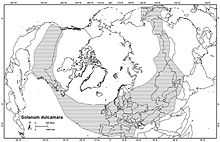Solanum dulcamara
| Bittersweet Nightshade | |
|---|---|
 | |
| Solanum dulcamara[1] | |
| Scientific classification | |
| Kingdom: | Plantae |
| (unranked): | Angiosperms |
| (unranked): | Eudicots |
| (unranked): | Asterids |
| Order: | Solanales |
| Family: | Solanaceae |
| Genus: | Solanum |
| Species: | S. dulcamara |
| Binomial name | |
| Solanum dulcamara L.[2] | |
Solanum dulcamara, also known as bittersweet, bittersweet nightshade, bitter nightshade, blue bindweed, Amara Dulcis,[3] climbing nightshade, fellenwort, felonwood, poisonberry, poisonflower, scarlet berry, snakeberry,[4][5][6] trailing bittersweet, trailing nightshade, violet bloom, or woody nightshade, is a species of vine in the potato genus Solanum, family Solanaceae. It is native to Europe and Asia, and widely naturalised elsewhere, including North America, where it is an invasive problem weed.
Overview
It occurs in a very wide range of habitats, from woodlands to scrubland, hedges and marshes. It is an invasive species in the Great Lakes region and was first spotted in 1843.[7]
Bittersweet is a semi-woody herbaceous perennial vine, which scrambles over other plants, capable of reaching a height of 4 m where suitable support is available, but more often 1–2 meters high. The leaves are 4–12 cm long, roughly arrowhead-shaped, and often lobed at the base. The flowers are in loose clusters of 3–20, 1–1.5 cm across, star-shaped, with five purple petals and yellow stamens and style pointing forward. The fruit is an ovoid red berry about 1 cm long, soft and juicy, with the aspect and odor of a tiny tomato, and edible for some birds, which disperse the seeds widely. However, the berry is poisonous to humans and livestock, and the berry's attractive and familiar look make it dangerous for children.

It is native to northern Africa, Europe and Asia, spreading throughout the world. The plant is relatively important in the diet of some species of birds such as European thrushes that feed on its fruits and are immune to its poisons, scattering the seeds abroad. It grows in all types of terrain with a preference for wetlands and the understory of riparian forests. Along with other climbers, it creates a dark and impenetrable shelter for varied animals. The plant grows well in dark areas in places where it can receive the light of morning or afternoon. An area receiving bright light for many hours reduces their development. It grows more easily in rich wet soils with plenty of nitrogen.
Gallery
-

Flowers
-

Fruits
-
Solanum dulcamara
Biological activity
The stems are approved by the German Commission E for external use as supportive therapy in chronic eczema.[8]
The alkaloids, solanine (from unripe fruits), solasodine (from flowers) and beta-solamarine (from roots) inhibited the growth of E. coli and S. aureus.[9] Solanine and solasodine extracted from Solanum dulcamara showed antidermatophytic activity against Chrysosporium indicum, Trichophyton mentagrophytes and T. simil. and thus may cure ringworm.[10]
Although fatal human poisonings are rare, several cases have been documented. The poison is believed to be solanine.[11] Aggressive treatment of children ingesting limited amounts of ripened S. dulcamara berries appears to be unnecessary.[12]
References
| Wikiversity has bloom time data for Solanum dulcamara on the Bloom Clock |
| Wikispecies has information related to: Solanum dulcamara |
| Wikimedia Commons has media related to Solanum dulcamara. |
- ↑ illustration by Kurt Stüber, published in Prof. Dr. Otto Wilhelm Thomé Flora von Deutschland, Österreich und der Schweiz 1885, Gera, Germany
- ↑ Sp. Pl. 1: 185. 1753 [1 May 1753] "Plant Name Details for Solanum dulcamura". IPNI. Retrieved December 1, 2009.
- ↑ Culpeper Plant Names Database, discussing various editions of Culpeper, for example Culpeper, Nicholas, The English physitian: or an astrologo-physical discourse of the vulgar herbs of this nation, London, Peter Cole, 1652.
- ↑ Blanchan, Neltje (2005). Wild Flowers Worth Knowing. Project Gutenberg Literary Archive Foundation.
- ↑ "Almost any unfamiliar berry is or may be snake-berry, and all snake-berries are poisonous; so a boy dares not eat a berry till some one . . . ". Needs verification but may come from Fannie D. Bergen (November 1892). "Popular American Plant Names". Botanical Gazette 17 (11): 363–380. doi:10.1086/326860.
- ↑ "Guide to Poisonous and Toxic Plants (Technical Guide #196)". US Army center for health promotion and preventive medicine, Entomological Sciences Program. July 1994.
- ↑ "List of invasive species in the Great Lakes Great Lakes United / Union Saint-Laurent Grands Lacs". Retrieved 2009-02-07.
- ↑ "Bittersweet Nightshade professional information from". Drugs.com. Retrieved 2013-08-15.
- ↑ L. Kumar P., Sharma B., Bakshi N.,"Biological activity of alkaloids from Solanum dulcamara". Natural Product Research. 23 (8) (pp 719-723), 2009. Date of Publication: 2009.
- ↑ Bakshi N., Kumar P., Sharma M. "Antidermatophytic activity of some alkaloids from Solanum dulcamara." Indian Drugs. 45 (6) (pp 483-484), 2008.
- ↑ R. F. Alexander, G. B. Forbes, and E. S. Hawkins (1948-09-11). "A Fatal Case of Solanine Poisoning". Br Med J. 2 (4575): 518. doi:10.1136/bmj.2.4575.518. PMC 2091497. PMID 18881287.
- ↑ Hornfeldt CS. Collins JE. "Toxicity of nightshade berries (Solanum dulcamara) in mice". Journal of Toxicology - Clinical Toxicology. 28(2):185-92, 1990.

